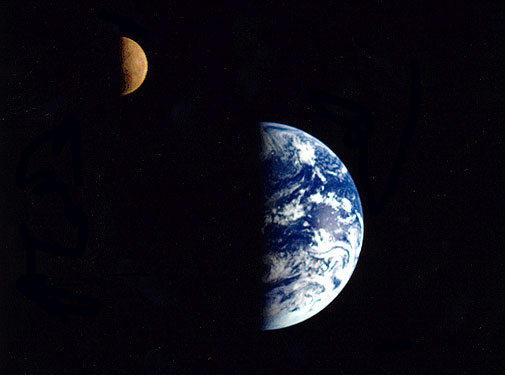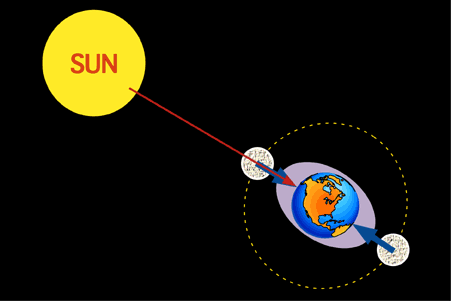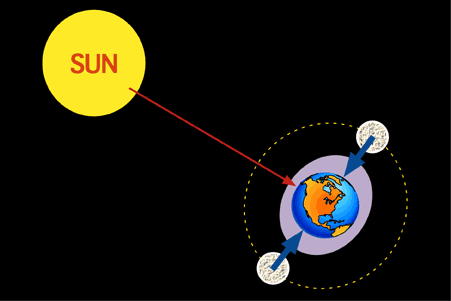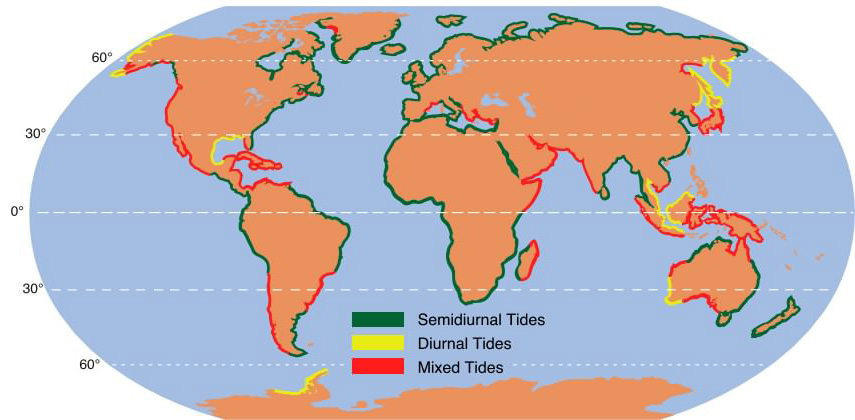Introduction
An ocean tide refers
to the cyclic rise and fall of seawater. Tides are caused
by slight variations in gravitational attraction
between the Earth and
the moon and the Sun in
geometric relationship with locations on the Earth's
surface. Tides are periodic primarily because of the
cyclical influence of the Earth's rotation.
The moon is the primary factor controlling
the temporal rhythm and height of tides (Figure
8r-1). The moon produces two tidal bulges
somewhere on the Earth through the effects of gravitational
attraction. The height of these tidal bulges is controlled
by the moon's gravitational force and the Earth's gravity
pulling the water back toward the Earth. At the location
on the Earth closest to the moon, seawater is drawn toward
the moon because of the greater strength of gravitational
attraction. On the opposite side of the Earth, another
tidal bulge is produced away from the moon. However,
this bulge is due to the fact that at this point on the
Earth the force of the moon's gravity is at its weakest.
Considering this information, any given point on the
Earth's surface should experience two tidal crests and
two tidal troughs during each tidal period.

The timing of tidal events is related to
the Earth's rotation and the revolution of the moon around
the Earth. If the moon was stationary in space, the tidal
cycle would be 24 hours long. However, the moon is in
motion revolving around the Earth. One revolution takes
about 27 days and adds about 50 minutes to the tidal
cycle. As a result, the tidal
period is 24 hours and 50 minutes in length.
The second factor controlling tides on
the Earth's surface is the Sun's gravity. The height
of the average solar tide is about 50% the average lunar
tide. At certain times during the moon's revolution around
the Earth, the direction of its gravitational attraction
is aligned with the Sun's (Figure 8r-2). During
these times the two tide producing bodies act together
to create the highest and lowest tides of the year. These spring tides occur
every 14-15 days during full and new moons.

Figure 8r-2: Forces
involved in the formation of a spring tide.
When the gravitational pull of the moon
and Sun are at right angles to each other, the daily
tidal variations on the Earth are at their least (Figure 8r-3).
These events are called neap
tides and they occur during the first and last
quarter of the moon.

Figure 8r-3: Forces
involved in the formation of a neap tide.
Types of Tides
The geometric relationship of moon and
Sun to locations on the Earth's surface results in creation
of three different types of tides. In parts of the northern
Gulf of Mexico and Southeast Asia, tides have one high
and one low water per tidal day (Figure 8r-4).
These tides are called diurnal
tides.

Figure 8r-4: Cyclical
tidal cycles associated with a diurnal tide.
Semi-diurnal
tides have two high and two low waters per
tidal day (Figure 8r-5). They are common on
the Atlantic coasts of the United States and Europe.

Figure 8r-5: Cyclical
tidal cycles associated with a semi-diurnal tide.
Many parts of the world experience mixed
tides where successive high-water and low-water
stands differ appreciably (Figure 8r-6). In
these tides, we have a higher high water and lower
high water as well as higher low water and lower
low water. The tides around west coast of Canada
and the United States are of this type.

Figure 8r-6: Cyclical
tidal cycles associated with a mixed tide.
The map in Figure 8r-7 shows the geographic
distribution of these three tide types on the Earth.

| Figure 8r-7: Global distribution of the three tidal types. Most of the world's coastlines have semidiurnal tides. |